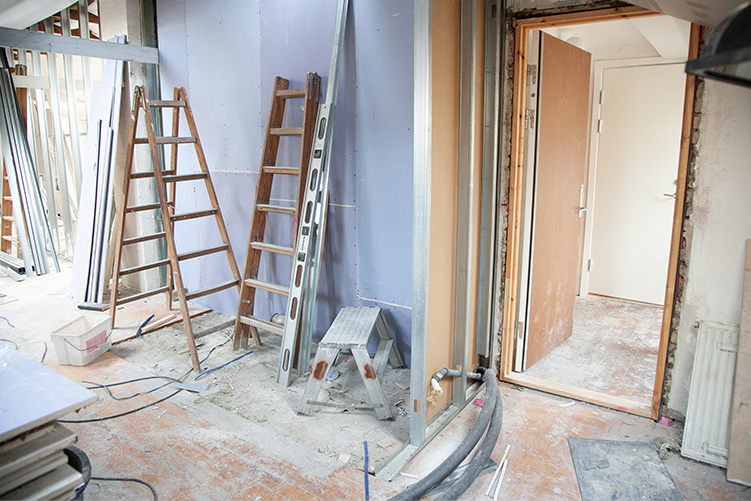If you’re thinking about refurbishing or renovating a property, unless you’ve got really deep pockets, you’ll probably need some sort of finance to fund the project.
It’s no secret that there’s plenty of money to be made in property, however, there’s also lots of costs and things to consider. Having an understanding of these beforehand is key to pulling off a successful project.
The options available to you will depend on your own circumstances and what you’re looking to achieve from the renovation. In this guide, we will outline the main ways you can fund a renovation project and highlight some of the pros and cons of each method.
There are several reasons you may require renovation finance. For example:
- Re-mortgaging for home improvements
- Buying a property to flip
- Buying a property to renovate & re-finance
Remortgage for home improvements (First charge)
Re-mortgaging your home can be a good way to release equity tied up in your property for home improvements. You will need to have a decent amount of equity in your home and be able to afford the monthly repayments for the additional borrowing.
There are several ways to go about re-mortgaging your home for home improvements. A good place to start is to go with your existing mortgage provider. This would be classed as a ‘first charge mortgage’ and is also referred to as a ‘further advance’.
If you speak with an independent mortgage broker like Strive, they will usually be able to compare the options available with both your current mortgage provider and the rest of the market.
If you’re mid-way through a fixed-rate mortgage, leaving your current provider will usually result in you paying a hefty early repayment charge, which is why it’s a good idea to approach your existing mortgage lender first to potentially avoid this.
Most mortgage lenders will allow you to re-mortgage up to 85% of the property value, although some will consider up to 90%. The mortgage lender will base the valuation on the property in its current state.
Example:
- £300,000 property value in the current state
- £180,000 existing mortgage
- £255,000 new mortgage- 85% LTV
- £75,000 released for home improvements
In the example above the customer would need to be able to evidence they can afford the full £255,000 mortgage and not just the additional £75,000.
If you’re re-mortgaging with your existing lender, your current mortgage will usually remain unchanged, and your additional borrowing will be arranged on a separate sub account, with a different interest rate. If your current mortgage provider will not allow you to borrow the amount you need, it may be worth re-mortgaging away from them.
It’s usually possible to secure the mortgage but not actually draw down on the funds until you require them. This way, you are not paying mortgage interest unnecessarily. The mortgage offers will usually be valid for 6 months.
Second charge for home improvements
A second charge mortgage, also known as a ‘secured loan’ or ‘second mortgage’ allows you to borrow money whilst leaving your existing mortgage in place.
Remortgaging when you are tied into a mortgage deal means you may incur an early repayment charge. By taking a second charge mortgage, you will avoid paying that penalty.
Most first-charge mortgage lenders limit borrowing to 4 to 5 times your income, but some specialist second mortgages may stretch this to 6 to 7 times your income, allowing you to borrow more.
The interest rates on second-charge mortgages are generally higher than on first-charge mortgages.
Buying a property to ‘flip’
Investing in property requires skills and know-how, this is particularly the case with flipping a property. Flipping a property is where you buy a property, renovate it, and sell it for a profit.
There are various finance options available to flip a property:
A residential mortgage to flip
When you buy a property with a residential mortgage, the affordability will be based on your income and outgoings. If you already have a residential mortgage, your income will need to be enough to cover both mortgages and the associated running costs, this can be a stretch for most people on regular incomes.
If you don’t already have a residential mortgage and you intend to live in the property, the affordability will be like any other residential mortgage, and you’ll generally be able to borrow between four to five times your income.
The benefit of a Residential mortgage is that you can potentially buy a property with as little as 5-10% deposit, although you will need to be able to afford the mortgage on the remainder of the property value.
Residential mortgages arranged on fixed-rate products will have early repayment charges for early redemption. If you are planning on selling the property in a short period of time, a fixed-rate mortgage may not be the best option. A variable or tracker product with no early repayment charges may be worth considering so you aren’t tied into a mortgage deal when you come to sell.
Most residential mortgages are arranged on a capital and interest repayment basis; therefore, the payments can be relatively high compared to some other forms of investment finance that may be available on interest only or with payments ‘rolled up’.
That said, the Interest rates available on residential mortgages are usually the cheapest of all the property finance options.
Speak To an Expert
Whether you’ve just had an offer accepted on a property and you’re ready to go, or you’re simply wondering how much you need to save for a deposit, it’s never too soon to reach out.
Pro’s of a residential renovation mortgage
- Potentially accept smaller deposits than other forms of renovation finance
- Lower interest rates & fees than other forms of finance
Con’s of a residential renovation mortgage
- Usually only available on a capital repayment basis
- They are based on your personal affordability
- Potential exit fees for early redemption on fixed-rate mortgages
Buying a property to flip – Bridging finance
Bridging is the ideal way to finance a flip – it allows you to take out a short-term loan so that you have the funding to do the flip, but you are not tied into a mortgage. Bridging loans are generally taken out for a term of between six months and a year, and you can normally borrow at around 75% LTV.
There are 2 types of bridging, open bridging and closed bridging;
Closed bridging
This is when a fixed date for the bridge repayment is set and agreed on contractually.
Closed bridging finance will generally have lower interest rates than opening bridging finance and has a greater likelihood of being accepted than open finance, this is because there is more certainty than with an open bridge.
Open bridging finance
Open bridging is more flexible than closed bridging finance because there is no set repayment date to clear the bridge. Because there is less certainty, the interest rates can be higher and the chances of acceptance lower.
Pros of bridging finance
- No exit fees
- Quick to arrange
- Options to make no repayments toward the loan throughout the term
- Can be arranged on a first or second charge basis
- Less stringent credit rating
- Lending is predominantly based on the property and repayment strategy rather than monthly affordability.
Cons of bridging finance
- Higher interest rates and fees -Standard bridging loans charge approximately 0.75-1.5% a month in interest for an open bridge, which works out up to 18% per year.
- Currently unregulated for invent purposes
- You can run into trouble if you have not sold the property and cleared the bridge within the agreed time.
- You will likely need a bigger deposit compared to a residential mortgage, generally a minimum 25%.
What costs are there to consider when flipping a property?
The costs of flipping a property will vary depending on your buying position, the intended use of the property and the finance you use to purchase it.
Stamp Duty
If you are buying the property as your main residence and do not own any other properties, you will usually be liable for either the first-time buyer or ‘home mover’ rates.
If you are buying as a second home or buy-to-let, you will most likely be liable to pay additional stamp duty.
Renovation costs
These will vary depending on the specification & work required, it’s always worth getting quotes from several tradesmen and allowing for a contingency fund, it’s common for build costs to go over the initial quote.
Solicitor costs
The conveyancing costs will vary depending on the property type and purchase price.
It will typically cost around £1,600 – £2,200 for a freehold property or £1,700 – £2,500 for a leasehold property.
If you’re flipping the property, you will need to pay conveyancing costs on both the purchase and the sale, it’s usually a little cheaper when selling a property.
The conveyancing costs will typically cost around £1,000 – £1,500 when selling a property.
Estate agency fees
When flipping a property, you will need to factor in the purchase and sale costs.
Estate agency fees will vary depending on the deal you negotiate with an estate agent but will typically be around 1% of the property value + VAT.
Finance costs
The finance costs will vary depending on the type of finance you use to fund the property. You may be required to pay valuation fees, mortgage arrangement fees and mortgage broker fees.
If you’re arranging a mortgage which has exit fees for early redemption, you will also need to factor these in.
Professional fees
Building Control – For certain renovations or refurbishments, building control officers will be required to visit the site at intervals to ensure work confirms to building regulations, this will typically be around £500 – £800
Architect fees – If your renovation requires the services of an architect, the costs will vary depending on the size and nature of the project – For example, the drawings and plans for planning permission for an extension or conversion, you can expect costs of between £2,000 to £4,000,
Property running costs
You will need to consider the monthly running costs of the property, for example, the council tax, utility bills and monthly mortgage payments if you’re not arranging ‘rolled up’ bridging finance.
Capital gains tax
Anytime you sell a property and receive more for it than you paid, you may be liable to pay capital gains tax.
Capital gains tax (CGT) is payable on the sale of second homes and buy-to-let property.
If you sell your only or main home, you do not have to pay capital gains tax (CGT) on any profit if it has been your only or main home throughout the entire period of ownership.
CGT is currently (01/03/2023) charged at the rate of either 10% or 18% for basic rate taxpayers. For higher or additional rate taxpayers, the rate is either 20% or 28%
Allowable capital costs can also be deducted from any chargeable gain on the sale of a second home or buy-to-let property.
Buying a property to renovate & refinance (BRR)
This is a strategy where you buy a property, usually below market value, renovate it to add value and then refinance it. It’s a strategy also known as BRR.
This can be a great way of increasing your portfolio quickly or getting back some of your initial investment. It’s usually arranged with specialist mortgage lenders, here’s a simple example of how it works in principle.
A property is purchased for £100,000 with a 75% LTV mortgage (£75,000). You would need to fund the 25% deposit and any associated buying costs as well as the renovation costs (£5,000).
Once the renovation is complete, the property is worth £135,000, you can re-mortgage up to 75% of the new value (£101,250) and pocket the difference between this and your previous mortgage of £75,000 (£26,250).
You could then use these funds to fund a further purchase a property whilst keeping the initial and receiving rental income.
How can Strive Mortgages help?
Renovating a property requires a serious amount of consideration, and there are several ways to fund a project. Having a broker with experience arranging mortgages for renovations to help you understand all the options available to you will give you the best chance of success with your application. Contact us today.
For more info on renovation mortgages, please contact a member of the Strive team, by emailing info@strivemortgages.co.uk or call us on 01273 002697.




